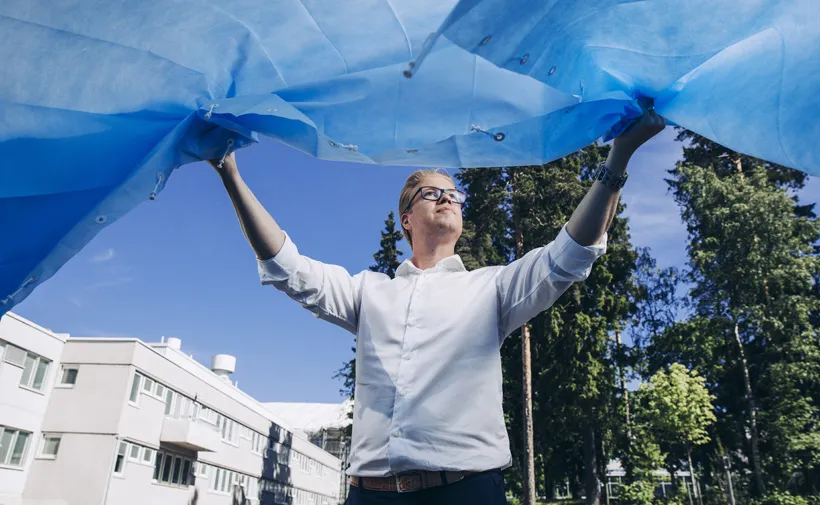Health technology exports bring a hefty amount of euros into Finland

There is strong demand for Finnish health technology around the world: last year, the sector’s exports grew to EUR 2.2 billion. One of the newcomers is Elers Medical Finland, led by CEO Niklas Elers, who is determined to defeat hospital-acquired infections.
According to Finnvera’s Finance Manager Laura Laine, Elers Medical Finland is a good example of Finnish health technology know-how. The enterprise already has global networks, invests in product development, possesses high-level expertise and is working to solve a major problem.
“There is a global search for solutions for the prevention of illnesses, personalised health care and bacterial resistance as well as generally more cost-efficient operating models. There is still plenty of potential for growing exports,” says Laine.
The Ministry of Social Affairs and Health has estimated the potential to amount to EUR 10–20 billion.
Last year, health technology exports grew faster than the global markets, by 5.3 per cent. The export figures do not include pharmaceuticals or well-being business. The largest target markets are the United States and the European Union.
“Large corporates act as drivers in this sector and use a lot of subcontracting in innovation activities. They could do even more to help smaller enterprises in sales and marketing. Especially opening the doors is important,” explains Laine.
According to her, exports by health care enterprises can also be seen at Finnvera, even though there are no sector-specific statistics. The product development cycle is long as the sector is strictly regulated. It takes a lot of financing to get to the marketing authorisation phase.
“In product development, the role of equity is crucial. After that, our financing contributes to working capital, investments and export trade transactions. Enterprises also use credit insurance and buyer financing. Especially the first deals are tough for the cash position as the enterprise has to wait for the money for a long time,” comments Laine.
As a solution, she brings up the leasing model. In public procurement, products could be leased instead of being sold; in other words, the use of the product could be sold as a service. This would accelerate decision making and generate continuous cash flow for the enterprise.
Controlling hospital-acquired infections
Elers Medical Finland is only three years old but the turnover of the fast-growing group of companies will already exceed EUR 2 million this year.
Elers Medical has invested strongly in product development. The products developed by it help to prevent the spread of hospital-acquired infections. The group company Gabriel Scientific has patented filter-ventilated cushioning products.
“At the moment, we manufacture and distribute patented hygienic pillows, duvets and mattresses and antibacterial hospital curtains for hospital patient rooms. Product groups are exported to approximately 40 different countries. The World Health Organization has calculated that in the USA and the EU alone, more than 100,000 people die of hospital-acquired infections,” says CEO Niklas Elers.
For the manufacture of antibacterial curtains, Elers Medical has established a factory in China. China was selected as the manufacturing site on the basis of the geographic location of raw materials and subcontractors. In the future, Elers Medical intends to invest in curtain production in Finland, too.
The international growth of this Helsinki-based company is boosted by a significant retail agreement with an English company. The agreement period is two years.
“Our goal is to become the principal of EUR 10–50 million retailers. Well, the English company is in the billion category.”
Elers himself has a commercial background. His career has given him a good overall picture of how things work in the hospital world.
Networking and international operations are key factors. The enterprise’s management is based not only in Helsinki but also in Ireland, Scotland and China. In addition, there are altogether nearly 30 employees in China and Estonia. In product development alone, work has been outsourced to three engineering offices.
Elers Medical also has an American venture capital investor as a minority shareholder. The venture capital investor came in in connection with Team Finland’s R&D project a year ago.
“At their highest, product development costs have been EUR 300,000 per year. Now the products are ready, even though we of course think about new products, too. Luckily, we have had the right people and an existing global network. If we had had to start from scratch, we would never have seen the light of day,” notes Elers.
Exporting requires money
It is not cheap to build an international enterprise.
Elers calculates that the personal savings he has used amount to a six-figure sum. In addition, investors have provided financing. Finnvera, Business Finland and OP Corporate Bank plc have provided Elers Medical with, for instance, a Start Guarantee, an R&D loan, internationalisation and trade fair grants, a loan guarantee for exports and various loans.
“We get money from the client gradually. Either after 60 days if the product has arrived at the destination or at the latest after 80 days. Taking risks does not feel so bad when there is demand for products anyway,” says Elers.
Finnvera’s Laine urges also other SMEs seeking international growth to take the preparation of financial and cash flow calculations seriously.
“Enterprises must know the market and calculations have to be realistic. Financing must be considered as part of the growth plan. At the same time, it is good to identify the risks. The protection of sales receivables is one of the most important tasks in an enterprise,” says Laine.
